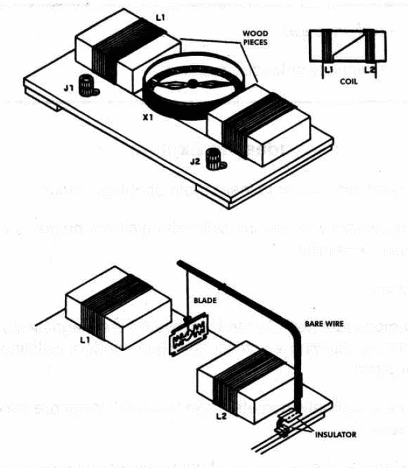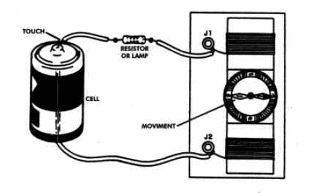The experimental galvanometer described here can detect currents as low as few microamperes and uses unusual parts. This galvanometer operates as common commercial galvanometers found in multimeters and several other analog instruments.
One purpose of this experiment can be to demonstrate that there is a magnetic field around a coil that that is carrying electricity (Oersted Experiment).
The operating principle is very simple to understand: an electric current flowing across a coil (or a wire) produces a magnetic field. The field can act on a mobile magnetic metal piece, such as a compass pointer or a blade, as shown in the figures herein.
The compass or blade movement indicates the presence of a current.
Figure 1 shows the two basic versions of the experimental galvanometer, using a common compass and using a blade.

Is very important to observe the correct path for the current flow in the coil.
The coil should be wired exactly as shown in the figure.
In Figure 2 we have a circuit to operate the galvanometer.

The resistor can range from 100 to 100,000 Ω. The higher the resistor, the more sensitive is the galvanometer.
Experiment to find the highest resistor value that can cause the pointer to move.
The coil is made with 50 to 200 turns of No. 28 to 32 wire on a paper form.
Number of turns determines sensitivity. The higher the number of turns, the more sensitive is the galvanometer.
Currents as low as a few microamperes can be detected with a carefully made prototype.
Experimental Galvanometer
L1 - coil - see text
X1 - Compass or blade - see text
Ideas to Explore
To get better performance or to learn more about the circuit:
Experiment with several coils with different numbers of turns and compare sensitivity.
Science projects:
Demonstrate how Oersted discovered the magnetic field around a wire that is carrying electricity and how modern galvanometers are constructed.
Where can galvanometers can be used? What are voltrneters and ammeters?
Determine the sensitivity of your galvanometer by connecting it in series with a multimeter (DC mA or µA scale) and a 100,000 ohm potentiometer.



